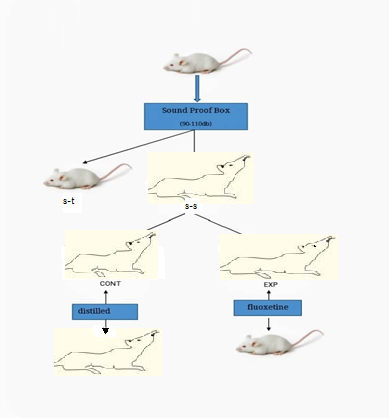-
Home
-
About JCTR
-
Gold Open Access
-
Issues
-
Editorial board
-
Author guidelines
-
Publication fees
-
Online first
-
Special issues
-
News
-
Publication ethics
-
Partners
-
Submit your manuscript
-
Submit your review report
-
Editorial Office
-

This work is licensed under a Creative Commons Attribution-NonCommercial 4.0 International License. ISSN print: 2382-6533 ISSN online: 2424-810X
Volume 7 issue 2
Effect of fluoxetine on seizures in rats with high susceptibility to audiogenic stress
Khadija Ismayilova, Ulduz Hashimova, Mohammad Reza Majidi, Farhad Rustamov*
Ismayilova et al. J Clin Transl Res 2021; 7(2):16
Published online: April 22, 2021
Abstract
Background: The seizures, triggered by a loud sound in laboratory animals, are associated with the imbalance of the brain monoamines. Serotonin (5-HT) is regarded as one of the principal neurotransmitters to be involved in regulation of wide variety of physiological and psychological processes. Among the drugs that affect 5-HT synaptic transmission, the leading role is given to selective serotonin reuptake inhibitors (SSRIs), such as fluoxetine.
Aim: The aim of the study is to investigate the effects of fluoxetine on seizures in Wistar rats with high susceptibility to audiogenic stress.
Methods: The study was performed on male Wistar rats. Prior to the experiments, the animals were tested for susceptibility to audiogenic seizures by exposure to a sound of 90-110 dB for 2 min in the soundproof box. The difference between congenital susceptibility to seizures served as a basis for dividing animals into 2 groups: seizure-susceptible (SS) and seizure-tolerant (ST) rats. One h prior to the experiment, the experimental animals were orally administered with fluoxetine, while the control rats were treated with distilled water. The effect of fluoxetine on the level of the biogenic amines in different regions of the brain was determined by enzyme-linked immunosorbent assay (ELISA).
Results: It has been shown that in 100% of the cases, the control SS rats, exposed to audiogenic stimulus, exhibited wild running around in circles and jumping as some of the signs of seizure responses that evolved into tonic-clonic seizures in 70% of the cases. As regards the experimental SS animals: only in 60% of the cases (р<0.05) they exhibited wild running and flinch, which did not evolve into the tonic-clonic phase.
Conclusions: Decreased manifestation of seizures in the experimental SS rats under acute administration of fluoxetine may be explained by highly distinctive repertoire and spatial distribution of 5-HT receptors in their brain structures in comparison to the ST rats.
Relevance for patients: The study of the monoaminergic mechanisms of seizure generation is of practical importance due to the existence of pharmacological agents, which selectively affect the activity of the monoaminergic systems of the brain, as well as the metabolism of the monoamines synthesized by them.

DOI: http://dx.doi.org/10.18053/jctres.07.202102.016
Author affiliation
Academician Abdulla Garayev Institute of Physiology, Azerbaijan National Academy of Sciences (ANAS), Baku, Azerbaijan
*Corresponding author
Farhad Rustamov
Academician Abdulla Garayev Institute of Physiology, Azerbaijan National Academy of Sciences (ANAS), Baku, Azerbaijan
Email: farkhadrust@gmail.com
Handling editor:
Michal Heger
Department of Pharmaceutics, Utrecht University, the Netherlands
Department of Pharmaceutics, Jiaxing University Medical College, Zhejiang, China

